Hydrogen energy related research and development efforts in Canada: A perspective
1 INTRODUCTION
Hydrogen is known as the lightest chemical element and potentially one of the greatest energy solutions for achieving better energy economy, cleaner environment, better sustainability and brighter future. In addition, it appears to be a key fuel, a unique energy carrier and an essential commodity to produce other chemicals and fuels.
Worldwide, there have been noteworthy efforts regarding hydrogen energy research and developments (R&Ds). The discovery of hydrogen is dated back to the 15th century. Hydrogen was first artificially produced in gas form by Phillip von Hohenheim, but at that time, he was not aware that a new flammable chemical element was produced. In 1671, Robert Boyle conducted an experiment with different metals via dipping them into acid. Hydrogen gas was produced during the experiment by the reaction called single-displacement, and he noted the fumes were flammable. When the date showed 1776, the first hydrogen-related research paper was published by Henry Cavendish, confirming that hydrogen is a distinct element and flammable.1 Today, Cavendish's study is considered a cornerstone for hydrogen-related studies. One of the very first hydrogen energy related meeting activities was initiated with a milestone-type conference in Miami, USA, by Professor Nejat Veziroglu in 1974.2 Since then, hydrogen energy has become the subject area of many research activities.
Hydrogen, consisting of one proton and one electron, is the simplest and most abundant element on the Earth.3 However, hydrogen does not exist naturally in gas form. Instead, hydrogen occurs within a compound such as water (H2O). Therefore, hydrogen is an energy carrier, not an energy source. The distinction between energy carriers and sources is that energy carriers are the medium that transport energy from production to end-use. In contrast, energy sources are the original resource from which energy carriers can be produced.4 Instead of combustion, the use of hydrogen in a fuel cell to generate power produces only water and heat as byproducts. This feature can be considered as the primary importance of hydrogen within the nature-friendly energy concept. Hydrogen is appraised as a promising solution as a medium for transportation and storage of energy. However, it is difficult to keep hydrogen in condensed phase due to its low density. Therefore, regardless of the storage method, hydrogen has the lowest calorific value per unit of volume compared to conventional fuels.5 On the other hand, hydrogen-fueled power systems achieve much higher efficiency than that of conventional fuel-based power systems. Thus, the problem of low hydrogen storage density is compensated.6
The method of producing hydrogen has a crucial role in achieving cradle-to-grave nature-friendly hydrogen-based energy applications. Hydrogen can be produced via electrolysis of water or thermal processing of hydrocarbons. Today, more than three-quarters of industrial hydrogen is generated via natural gas or coal-based steam methane reforming (SMR) method.7 Fossil fuel-based hydrogen generation emits 830 million tons of CO2 annually, which corresponds to 2% of global CO2 emissions.8 Therefore, more and more research and funds are promoted to generate hydrogen within a more environmentally-benign manner. Figure 1 shows the annual renewable-based hydrogen generation ratios from 2010 to 2030. According to the International Energy Agency (IEA),9 0.36 million tons (Mts) of low-carbon hydrogen production was achieved in 2019. When annual global hydrogen generation is considered (69 Mts/year), it can be realized that clean hydrogen corresponds to around 0.52% of global hydrogen generation. It is targeted to reach 7.92 million tons of annual low-carbon hydrogen generation by 2030. In this regard, increasing the share of renewable energy resources such as wind, solar, biomass, nuclear, or hydro, in global energy supply breakdown, will play a key role in realizing this target.
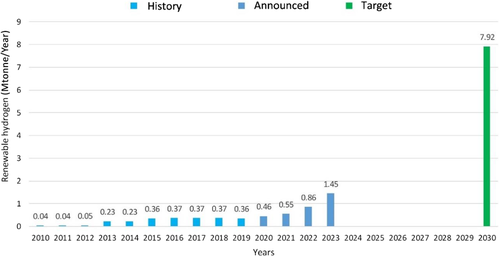
Hydrogen produced from natural gas or coal-based steam reforming method is called gray and black hydrogen, respectively. In some applications, CO2 occurring from fossil fuel-based hydrogen production is captured and stored; thus, the CO2 emission rates are mitigated. This hydrogen is called as blue hydrogen. Due to non-pollutant or less-pollutant characteristic, renewable-based hydrogen production is called as green hydrogen. With the production rate of 3 Mts/year corresponding around 4.35% of the global output, Canada takes place in the top 10 global hydrogen producers.10 Canada's hydrogen is almost 100% fossil fuel-based. On the other hand, with its large and diversified geographical characteristic, Canada has substantial renewable resources that can be employed to make Canada's hydrogen 100% green. Currently, about 18.9% of primary energy supply in Canada is from renewable.11 The ratio further increases if nuclear power is considered that providing 15% of Canada's electricity.12 In Figure 2, a potential renewable hydrogen pathway for Canada, is illustrated. Canada has a potential to implement this pathway by having all indicated renewable sources. However, policy support is needed to accelerate the economical viability of green hydrogen in Canada.
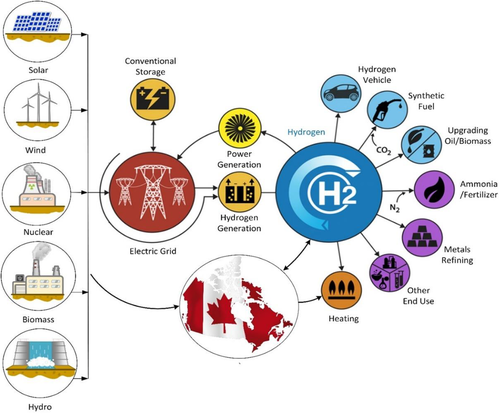
Hydrogen can greatly be generated from renewable energies by electrochemical or thermochemical processing of water. For the electrochemical process, electricity is needed to split water into hydrogen and oxygen. Therefore, low-carbon electricity from solar, wind, biomass or hydro can be utilized to generate green hydrogen. For the thermochemical-based water splitting, high temperature heat (500°C-2000°C) is required.14 For green hydrogen generation, the heat can be provided from concentrated solar or nuclear power plants. In Canada, there are 18 nuclear power plants in operation. Therefore, Canada has significant potential and an upper hand for green hydrogen transition. Since they can provide both electrical and thermal powers, nuclear power plants allow to use of both electrochemical and thermochemical hydrogen production methods such as conventional electrolysis, high temperature electrolysis, 3-, 4-, or 5- step copper-chlorine (Cu-Cl) cycles. Compared to conventional fossil fuel-based SMR that emits around 1.26 kg CO2/ kg hydrogen, the ratio can be decreased as low as 0.47 kg CO2/ kg hydrogen by promoting nuclear based hydrogen generation.5 Canada appears as well-positioned to respond the growing demand for green hydrogen.
Today, Canada has a hydrogen and fuel cell sector thriving in export markets with its global leaders in the sector such as Ballard Power Systems and Hydrogenics. Canadian hydrogen and fuel cell sector made $207 million profit in 2017 while employing more than 1600 people in Canada.10 Furthermore, Canada takes place in many international organizations focusing on hydrogen such as International Partnership for Hydrogen in the Economy (IPHE), Mission Innovation (MI), the Clean Energy Ministerial (CEM), the Hydrogen Ministerial, and IEA. Currently, the federal government of Canada is working on a comprehensive strategy for hydrogen to make the energy carrier a major component of Canada's net-zero green-house emission target by 2050.
In the current study, a comprehensive literature search is conducted for hydrogen-related research, development, and innovation in Canada over the last 50-year period. Data and information results are compiled and presented by considering hydrogen-related research articles, books and book chapters, research projects, patents, master and doctorate theses, and so on. Furthermore, Canadian institutes that have made the most considerable contribution to hydrogen by conducting research studies or sponsoring hydrogen-related research studies are evaluated.
2 MATERIALS AND METHODS
- Research papers, Conference papers and Reviews = Search “Hydrogen”; Affiliation: “Canada,” Time period: “1970 to 2020”; Source(s): Scopus.
- Books, Book Chapters and Editorial = Search: “Hydrogen”; Affiliation: “Canada,” Time period: “1970 to 2020”; Source(s): Scopus.
- Patents = Search: “Hydrogen”; Affiliation: “Canada,” Time period: “1970 to 2020”; Source(s): Canadian Intellectual Property Office.
- Research Projects = Search: “Hydrogen”; Affiliation: “Canada,” Time period: “1970 to 2020”; Source(s): Scopus.
- MSc and PhD Theses: “Hydrogen”; Affiliation: “Canada,” Time period: “1970 to 2020”; Source(s): Library and Archives Canada.
- Research papers = Search: “Hydrogen”; Subject area: “Energy”; Affiliation: “Canada,” Time period: “1970 to 2020”; Source(s): Scopus.
After implementing the search criteria described above, online data have been collected and compiled. The data is presented, analyzed, and discussed herein.
3 RESULTS AND DISCUSSION
In this section, all data regarding hydrogen studies conducted in Canada over the last 50-year period is presented with charts. Data and information collected from online sources are compiled in terms of articles, conference papers, reviews, books, book chapters, editorials, graduate theses, patents, and research projects conducted in the field. Furthermore, the Canadian institutes that conducted the most hydrogen-based energy studies are presented and discussed in the section. Figure 3 illustrates and covers all documents based on subject areas. The subject area of chemistry appears as the number one in which the most hydrogen-related work was performed followed by biochemistry, genetics, molecular biology, and physics and astronomy, respectively. The data is compiled by avoiding any potential field conflicts regarding the attribution of a single interdisciplinary publication more than once. However, a potential side impact of chemistry on biochemistry, genetics and molecular biology areas should be noticed.
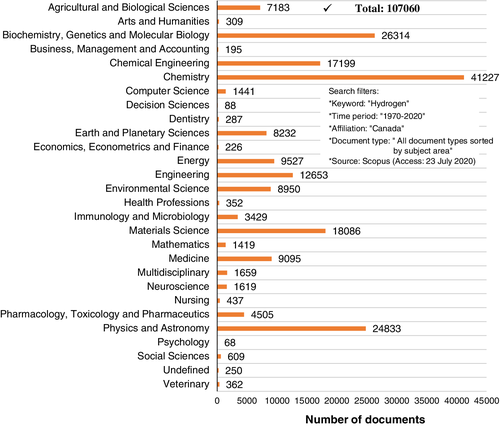
Articles, conference papers, and reviews cover more than three quarters of total hydrogen- related works done in Canada over the last 50 years. In this regard, 2019 appears as the most productive year with total number of 4979. It should be noted that the year of 2020 was not over when this study being conducted. As of August 2020, there are 103 221 hydrogen-related papers affiliated to Canada. From 1970 to the present, the number of work done in this field has increased consistently. However, due to the pandemic, 2020 might be less productive compared to previous years. Figure 4A shows the hydrogen-related articles, conference papers and reviews breakdown based on publication year. Ontario has been the province from which the most Canadian hydrogen-related publications came out over the last 50 years (See Figure 4B).
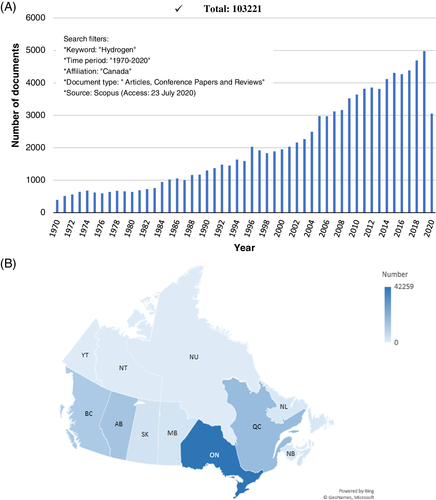
The hydrogen-related books, book chapters, and editorials affiliated to Canada from 1970 to 2020 are shown in Figure 5. The year 2010 appears to be a milestone in this regard. There were 112 hydrogen-related books, book chapters and editorials in 2009, whereas the numbers have increased by double and become 206 in 2010. The years 2018 and 2012 have been the most productive years, with the total number of works 265 and 244, respectively.
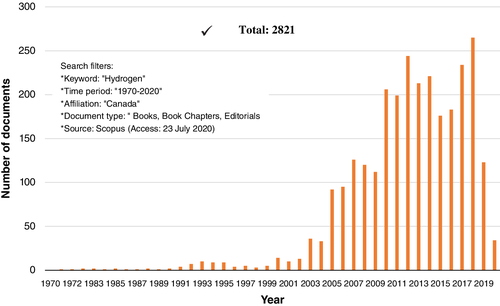
Based on data and information from Library and Archives Canada, 4112 hydrogen-related MSc and PhD theses were completed over the last 50 years (See Figure 6). It should be noted that this figure reflects the number of hydrogen-related theses entered to the system as of August 2020. Therefore, the corresponding figure is subject to change if there is new data entry to Library and Archives Canada. The current data shows that the year in which the highest number of theses completed in this area was 2013 with the number of 302.Data and information provided by the Canadian Intellectual Property Office show that there have been 15 127 hydrogen-related patents over the 50 years. Figure 7 indicates that 2006, 2007, and 2008 were the most generative years in a row with a number of 649, 636, and 620 patents, respectively.
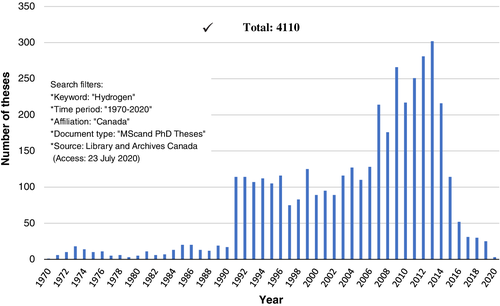
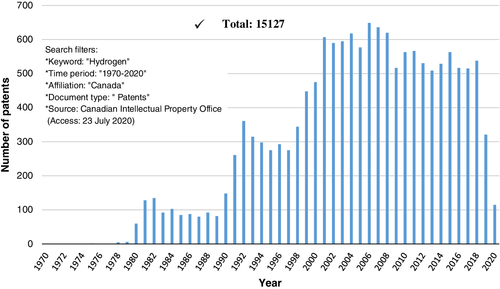
Another evaluated parameter within the scope of this study is the number of hydrogen-related research projects. Figure 8 shows the results in this regard. Natural Sciences and Engineering Research Council of Canada (NSERC) have funded 17 478 hydrogen-related types of research in Canada so far; thus, NSERC can be considered as the agency that played a major role in Canada's accomplishment in hydrogen studies. In total, there have been 71 786 hydrogen-related research projects in Canada funded by domestic and international agencies from 1970 to the present.
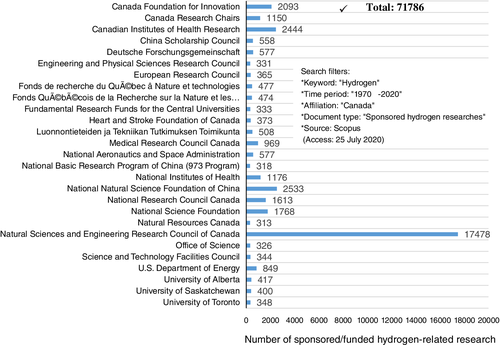
Today, hydrogen is considered one of the key players in a global nature-friendly energy transition. Figure 9 presents search results based on hydrogen-related research in the subject area of energy. Data and information received from Scopus show that there have been 9535 hydrogen-related energy studies in Canada so far. Despite being founded in 2002, The 18-year old Ontario Tech University appears as the pioneering institute of Canada in hydrogen-based energy research by conducting 905 research projects so far. Beyond any doubt, Clean Energy Research Laboratories (CERLs) at Ontario Tech University played a major role in this success by providing a very productive working environment to its researchers. Figure 10 presents the top six Canadian institutes contributing the most to hydrogen-related energy research activities. Production of the highest number of articles regarding hydrogen energy is considered to identify the most productive university in this regard. Furthermore, books, graduate theses, and patents are other assessment criteria used in Figure 10. In terms of articles and books related to hydrogen in the energy field, Ontario Tech University appears as the most productive institute of Canada. The University of British Columbia has the highest number of patents in this field, with a value of 111.
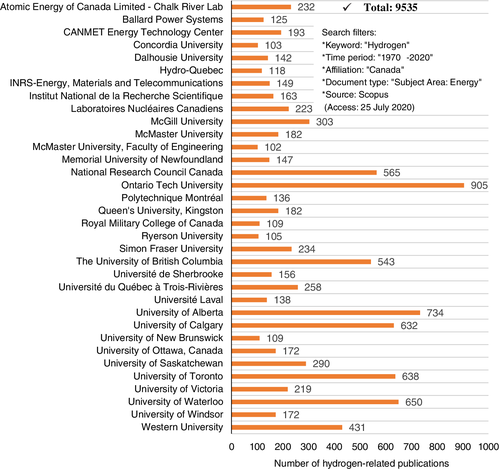
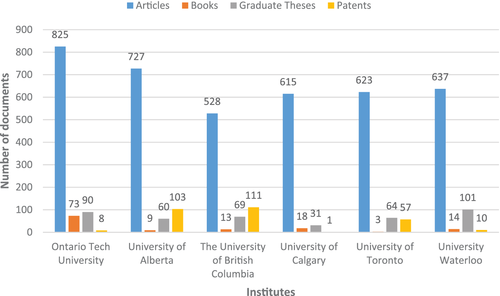
4 CONCLUSIONS
- The total number of hydrogen-related studies of Canada over the last 50 years was 107 060 in 28 different subject area.
- In terms of articles, conference papers and reviews, the total number of conducted studies was 103 221 from 1970 to 2020.
- In terms of books, book chapters and editorials, hydrogen-related publication of Canada was 2821.
- A total of 71 786 hydrogen-related research projects were completed in Canada so far.
- 4110 hydrogen-related MSc and PhD theses completed in various institutions across Canada.
- In the subject area of energy, Ontario Tech University has become the pioneering Canadian Institute by conducting 905 hydrogen-related research studies.
In closing, hydrogen has become the subject of many Canadian research over the last 50-year period. As a clean energy carrier, hydrogen attracts a tremendous amount of funds and countless researchers' attention across the globe. Producing hydrogen in a nature-friendly manner is the main subject of current hydrogen-related studies. While moving quickly towards more environmentally-benign energy transition, Canada can lead the globe in promoting green production processes as well as energy applications of hydrogen by relying on her world-rank institutes that have countless experiences in the field.




